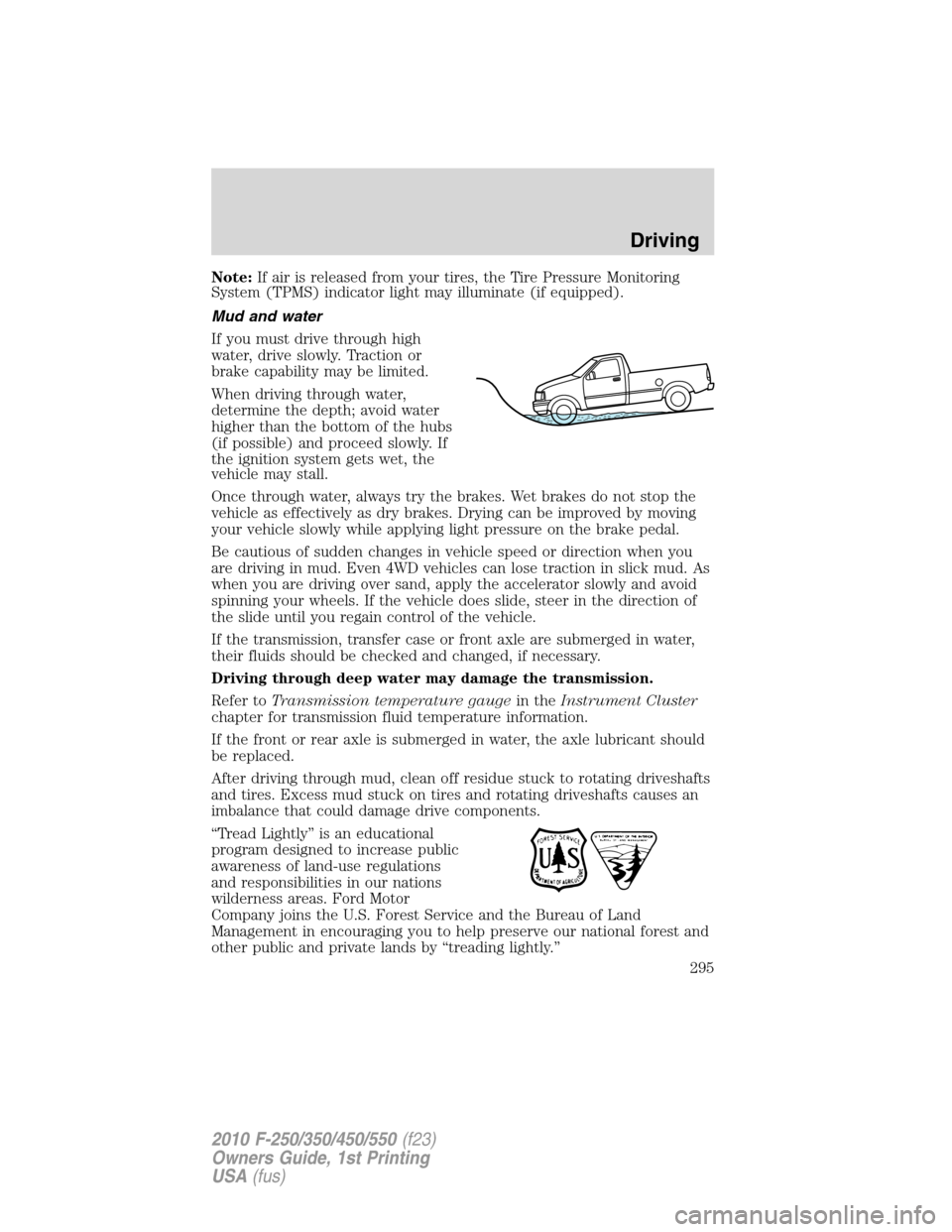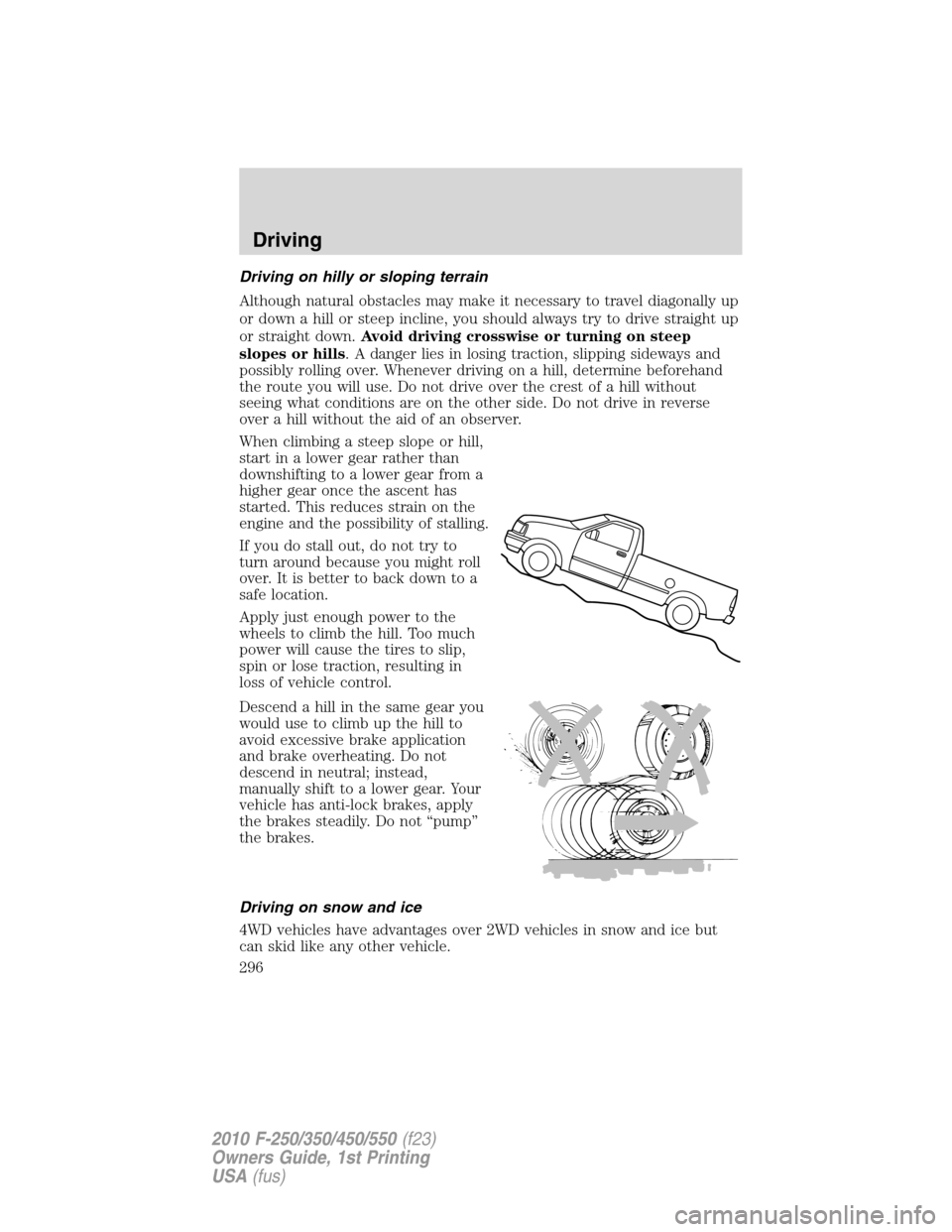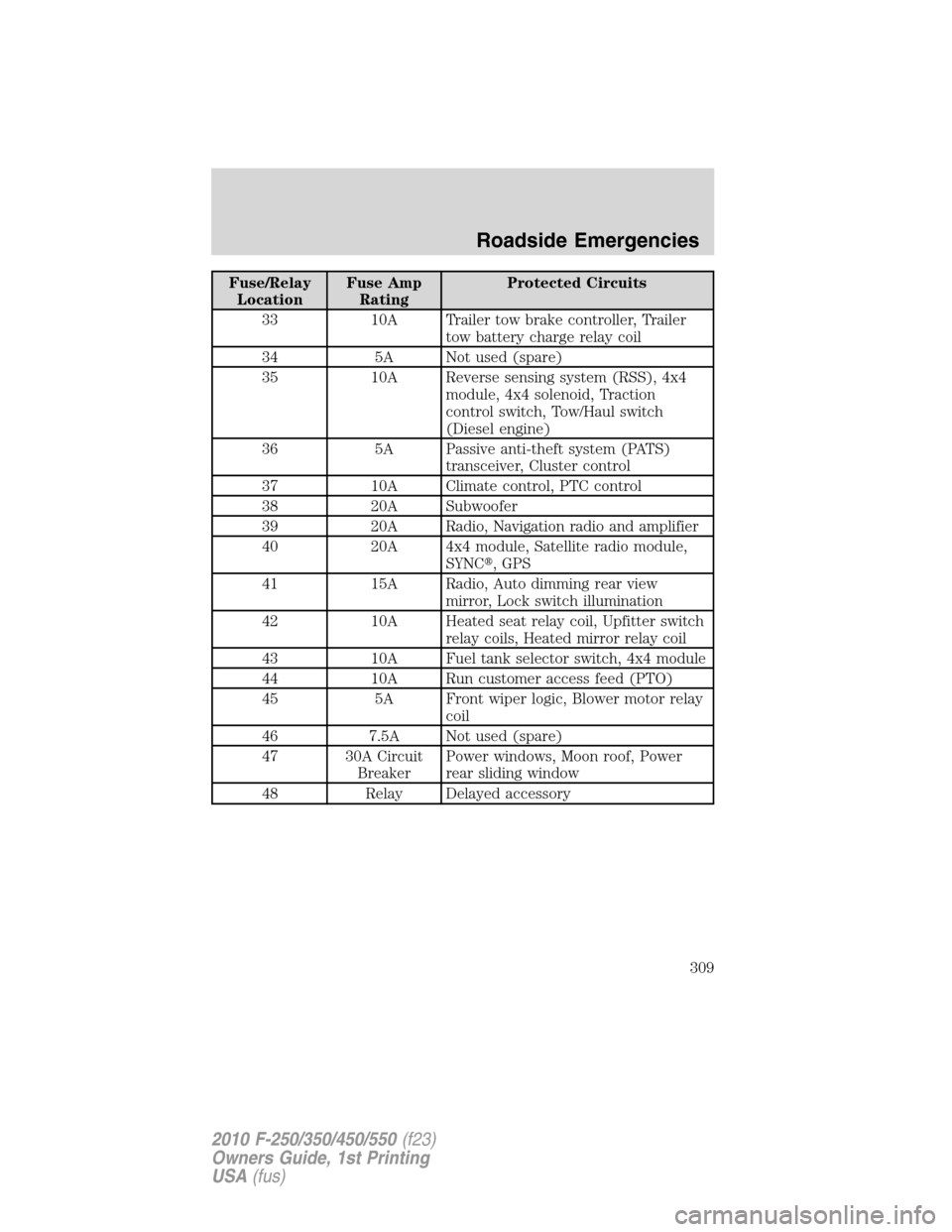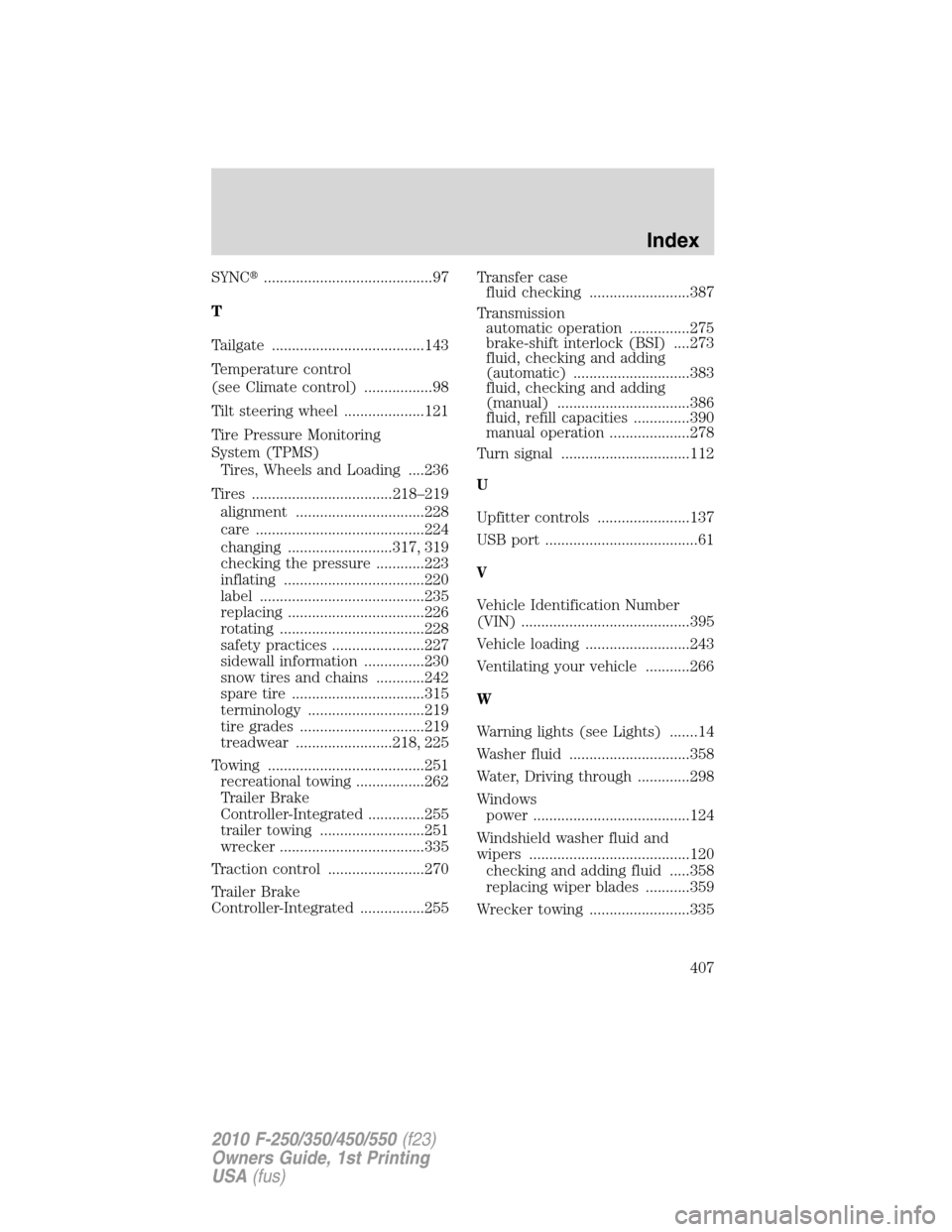Page 295 of 407

Note:If air is released from your tires, the Tire Pressure Monitoring
System (TPMS) indicator light may illuminate (if equipped).
Mud and water
If you must drive through high
water, drive slowly. Traction or
brake capability may be limited.
When driving through water,
determine the depth; avoid water
higher than the bottom of the hubs
(if possible) and proceed slowly. If
the ignition system gets wet, the
vehicle may stall.
Once through water, always try the brakes. Wet brakes do not stop the
vehicle as effectively as dry brakes. Drying can be improved by moving
your vehicle slowly while applying light pressure on the brake pedal.
Be cautious of sudden changes in vehicle speed or direction when you
are driving in mud. Even 4WD vehicles can lose traction in slick mud. As
when you are driving over sand, apply the accelerator slowly and avoid
spinning your wheels. If the vehicle does slide, steer in the direction of
the slide until you regain control of the vehicle.
If the transmission, transfer case or front axle are submerged in water,
their fluids should be checked and changed, if necessary.
Driving through deep water may damage the transmission.
Refer toTransmission temperature gaugein theInstrument Cluster
chapter for transmission fluid temperature information.
If the front or rear axle is submerged in water, the axle lubricant should
be replaced.
After driving through mud, clean off residue stuck to rotating driveshafts
and tires. Excess mud stuck on tires and rotating driveshafts causes an
imbalance that could damage drive components.
“Tread Lightly” is an educational
program designed to increase public
awareness of land-use regulations
and responsibilities in our nations
wilderness areas. Ford Motor
Company joins the U.S. Forest Service and the Bureau of Land
Management in encouraging you to help preserve our national forest and
other public and private lands by “treading lightly.”
Driving
295
2010 F-250/350/450/550(f23)
Owners Guide, 1st Printing
USA(fus)
Page 296 of 407

Driving on hilly or sloping terrain
Although natural obstacles may make it necessary to travel diagonally up
or down a hill or steep incline, you should always try to drive straight up
or straight down.Avoid driving crosswise or turning on steep
slopes or hills. A danger lies in losing traction, slipping sideways and
possibly rolling over. Whenever driving on a hill, determine beforehand
the route you will use. Do not drive over the crest of a hill without
seeing what conditions are on the other side. Do not drive in reverse
over a hill without the aid of an observer.
When climbing a steep slope or hill,
start in a lower gear rather than
downshifting to a lower gear from a
higher gear once the ascent has
started. This reduces strain on the
engine and the possibility of stalling.
If you do stall out, do not try to
turn around because you might roll
over. It is better to back down to a
safe location.
Apply just enough power to the
wheels to climb the hill. Too much
power will cause the tires to slip,
spin or lose traction, resulting in
loss of vehicle control.
Descend a hill in the same gear you
would use to climb up the hill to
avoid excessive brake application
and brake overheating. Do not
descend in neutral; instead,
manually shift to a lower gear. Your
vehicle has anti-lock brakes, apply
the brakes steadily. Do not “pump”
the brakes.
Driving on snow and ice
4WD vehicles have advantages over 2WD vehicles in snow and ice but
can skid like any other vehicle.
Driving
296
2010 F-250/350/450/550(f23)
Owners Guide, 1st Printing
USA(fus)
Page 309 of 407

Fuse/Relay
LocationFuse Amp
RatingProtected Circuits
33 10A Trailer tow brake controller, Trailer
tow battery charge relay coil
34 5A Not used (spare)
35 10A Reverse sensing system (RSS), 4x4
module, 4x4 solenoid, Traction
control switch, Tow/Haul switch
(Diesel engine)
36 5A Passive anti-theft system (PATS)
transceiver, Cluster control
37 10A Climate control, PTC control
38 20A Subwoofer
39 20A Radio, Navigation radio and amplifier
40 20A 4x4 module, Satellite radio module,
SYNC�, GPS
41 15A Radio, Auto dimming rear view
mirror, Lock switch illumination
42 10A Heated seat relay coil, Upfitter switch
relay coils, Heated mirror relay coil
43 10A Fuel tank selector switch, 4x4 module
44 10A Run customer access feed (PTO)
45 5A Front wiper logic, Blower motor relay
coil
46 7.5A Not used (spare)
47 30A Circuit
BreakerPower windows, Moon roof, Power
rear sliding window
48 Relay Delayed accessory
Roadside Emergencies
309
2010 F-250/350/450/550(f23)
Owners Guide, 1st Printing
USA(fus)
Page 407 of 407

SYNC�..........................................97
T
Tailgate ......................................143
Temperature control
(see Climate control) .................98
Tilt steering wheel ....................121
Tire Pressure Monitoring
System (TPMS)
Tires, Wheels and Loading ....236
Tires ...................................218–219
alignment ................................228
care ..........................................224
changing ..........................317, 319
checking the pressure ............223
inflating ...................................220
label .........................................235
replacing ..................................226
rotating ....................................228
safety practices .......................227
sidewall information ...............230
snow tires and chains ............242
spare tire .................................315
terminology .............................219
tire grades ...............................219
treadwear ........................218, 225
Towing .......................................251
recreational towing .................262
Trailer Brake
Controller-Integrated ..............255
trailer towing ..........................251
wrecker ....................................335
Traction control ........................270
Trailer Brake
Controller-Integrated ................255Transfer case
fluid checking .........................387
Transmission
automatic operation ...............275
brake-shift interlock (BSI) ....273
fluid, checking and adding
(automatic) .............................383
fluid, checking and adding
(manual) .................................386
fluid, refill capacities ..............390
manual operation ....................278
Turn signal ................................112
U
Upfitter controls .......................137
USB port ......................................61
V
Vehicle Identification Number
(VIN) ..........................................395
Vehicle loading ..........................243
Ventilating your vehicle ...........266
W
Warning lights (see Lights) .......14
Washer fluid ..............................358
Water, Driving through .............298
Windows
power .......................................124
Windshield washer fluid and
wipers ........................................120
checking and adding fluid .....358
replacing wiper blades ...........359
Wrecker towing .........................335
Index
407
2010 F-250/350/450/550(f23)
Owners Guide, 1st Printing
USA(fus)